Great! Out of my experiences came only one panel that had potential, but haven't found an
application for one that small. It ought to be checked again now at 4 years. Bruce Roe
Try our solar cost and savings calculator
Jesses DIY panel
Collapse
X
-
Well 8 years later and 3 out of the five panels are still pushing out some power amazingly it was the crappy painted backing panels that lasted the longest. Rather than full silicone covered cells I simply painted them with house paint lol. They must have dissipated heat better on the back. Either way I'm amazed they held up
amazingly it was the crappy painted backing panels that lasted the longest. Rather than full silicone covered cells I simply painted them with house paint lol. They must have dissipated heat better on the back. Either way I'm amazed they held up  one panel even has leaks and still pushes a measly 20w lol. Fun project at the time when panels were still fairly expensive. Nowadays they care cheap as.
one panel even has leaks and still pushes a measly 20w lol. Fun project at the time when panels were still fairly expensive. Nowadays they care cheap as.
Leave a comment:
-
Thanks for the reports. Any more info on the panel that failed? Bruce Roe2 years no leaks !!
Hi guys,
Two years in the field, they are still holding strong. Much to my delight, two years ago these DIY were worth it, today with prices having dropped Id be hard pressed to make more, but it was fun and will be interesting to see how they pan out. Ill post yearly updates for those interested hopefully some photos as we go.Leave a comment:
-
Read the whole thread. Interesting and really thought out. I like it.Leave a comment:
-
This is pretty impressive. Why don't you start a business with this? IDK if someone asked you this question or you already mentioned it in the forum...Leave a comment:
-
Thanks for the update!Leave a comment:
-
so 6 or 7 years later, one panel died, the rest are putting out normal amps! amazing they survived, some have slight moister in the cells, but this was from day one when they were sealed. So how long will they last now days panels are so cheap i would never bother doing this again, was fun at the time. I picked up a heap of 190w used panels for $50 a pop, they have no leaks and put out full amps, but i guess now you can make huge panels for the same cost i did back then. will find some pics and short amp readings when i get round to it.
now days panels are so cheap i would never bother doing this again, was fun at the time. I picked up a heap of 190w used panels for $50 a pop, they have no leaks and put out full amps, but i guess now you can make huge panels for the same cost i did back then. will find some pics and short amp readings when i get round to it.
Leave a comment:
-
2 years no leaks !!
Hi guys,
Two years in the field, they are still holding strong. Much to my delight, two years ago these DIY were worth it, today with prices having dropped Id be hard pressed to make more, but it was fun and will be interesting to see how they pan out. Ill post yearly updates for those interested hopefully some photos as we go.
The panels power my old mans cabbin, which he has retired to. They run a 24" LCD TV, Digital Tuner, Laptop, Surround speakers and 5 or so 15w lights off the panels, on average they are using about 60ah a day for all their needs, 400ah of T105 has held up for the last few years, still holding strong. Amazing to think two people can live off 60ah a day, but they've done it for two years, they said the LVD cut in once after two weeks of rain. They lower their usage accordingly but pretty cool to see. They are planning to up the TV size to 32" LED and drop the surround speakers, which should equal out to the old fluro driven LCD and old speakers.
Once the Trojans slow down , hopefully they get another 2 years out of them, Ill probably have a go at setting up a lithium 200ah battery bank, with the trojans as backup perhaps.Leave a comment:
-
Good work. your results are one of the few better thought out ones.Leave a comment:
-
How did you spread the silicone out?Hi everyone,
Well after lots of reading and dreaming I finally put together a DIY solar panel. Ive been facinated about solar since I was a kid, my parents have run their house on solar for almost 30 years. Their failful old BP 40w module still puts out 2 amps after 30 years.
After looking at a few DIY guides, I wasnt too impressed about the plywood designs, whilst they might work I have my doubts about them even lasting 5 years. So after hunting around some more I can across a site in Nicaragua, they use silcone (sylgard) to ecapsulate their cells. Then I found a few videos on youtube also. This looked like a much better way of weather proofing the cells. Also a lot of the earlier panels were made this way, some lasting 30 years plus.
So I orderd some evergreen string cells, and got to work.
However I whilst I orded the sylgard, it took weeks to arrive, in the meantime I was getting bits like glass and frame together in preperation. I came across some dowcorning silcone in the hardware store, it was electrical grade and non corrosive, it also can handle high temperatures and UV etc.
I came up with the idea of laying down the cells on the glass, then simply using the silicone caulk to seal the cells down. I completely sealed the cells with it, it came out $60 cheaper then sylgard (postage is $35). The result is I have the cells totally sealed in a similar silicone to sylgard, there is no worry about the caulk blocking the sunlight as its only on the sides and behind the cells. There are no bubbles infront of the cells either, a common problem with sylgard.
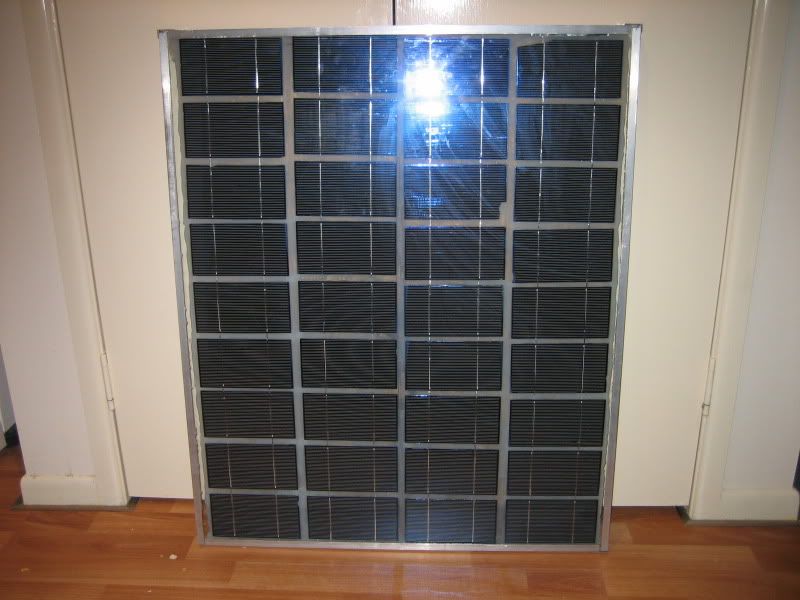
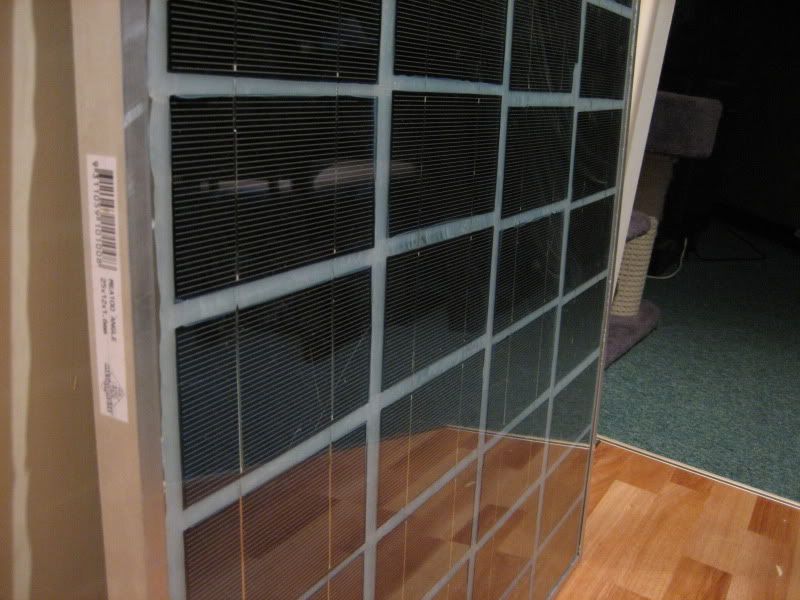
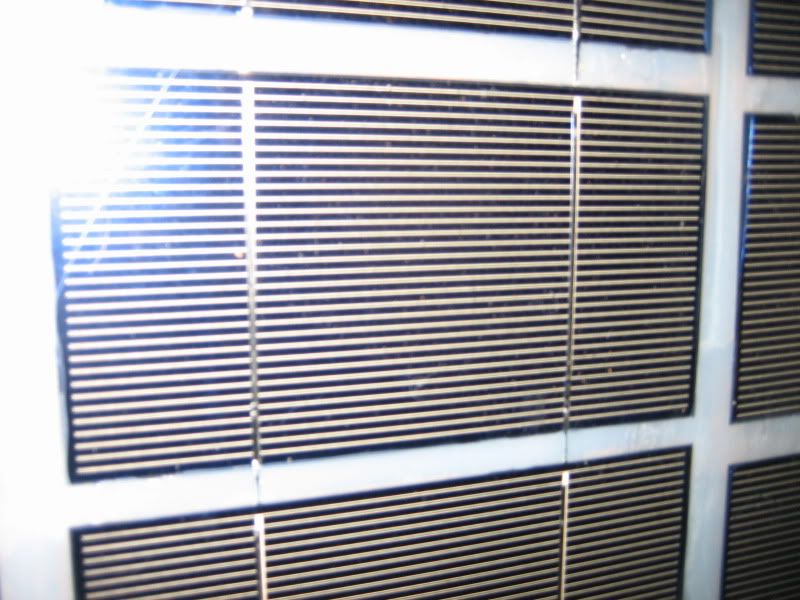
I was very suprised with the results of the panel, its putting out 3.7 amps and 20.5 volts. This drops to about 3.5 and 19 volts in scorching heat, lying flat on the ground also so no ventilation under the panel doesnt help. So its pretty close to a factory built 60w panel.
As you can see like anyone who has never handled solar cells before, i managed to chip some, unfortunately this effects all cells in the panel and drops the amps down a smidgen.
I have left the panel outside for a few weeks, through a storm and rain, minor hail. I even left it on wet grass in the sun for a few days, the back of the panel was soaked, but not one bit of moisture got into the cells. So im happy so far. I have chosen 5mm glass, after speaking to a guy that sold a lot of glass to a caravan park that used 5mm glass for their hotwater panels, he said they have been through heaps of hail storms with no worries.
Ive managed to pick up 5 second hand glass sheets for $3 a sheet 8mm shelving glass, i suspect its tempered, all up Ive worked out I can build the panels for about $140.
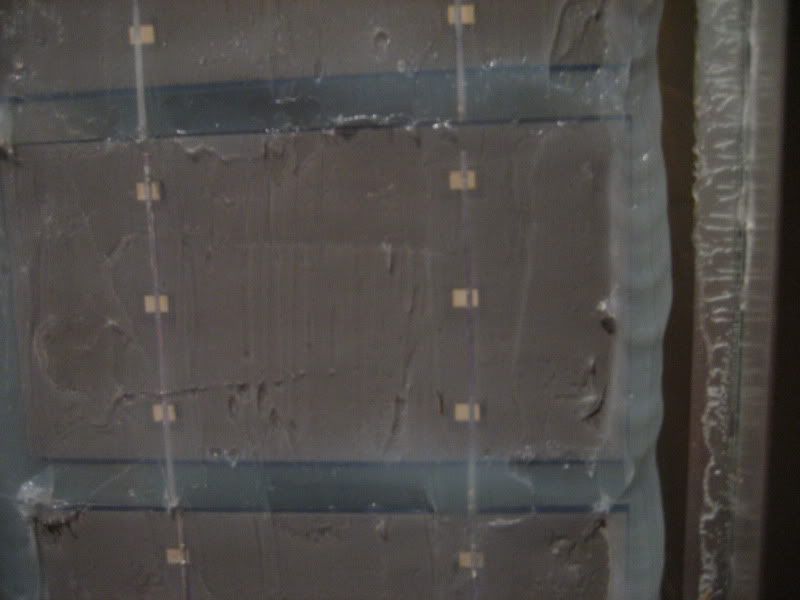
cell sealed with silcone.
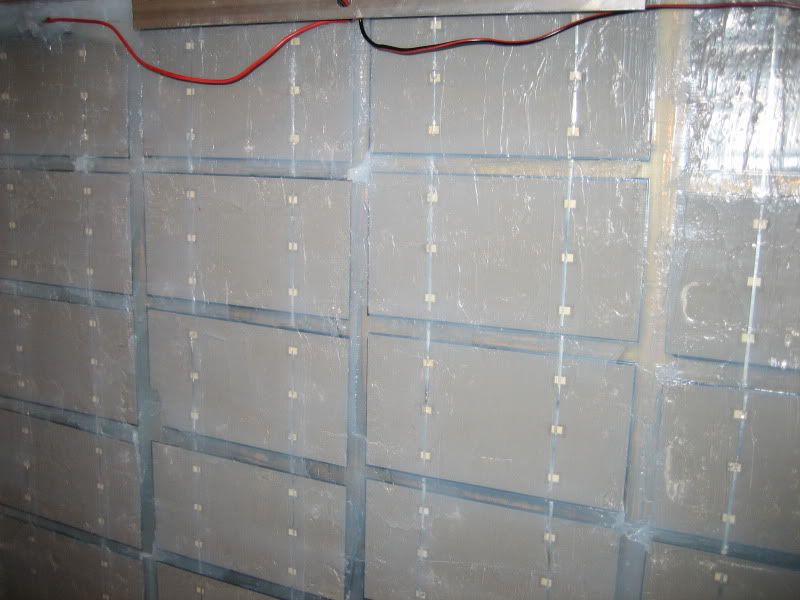
I have plans to use one for camping etc and give the rest to my parents for now, they are cheap to make, and Ill be keen to see how they last over time, most of all I get a buzz outta of it !!
being my first panel, it took a lot longer then I thought, next one should be easier.
Im also looking into sealing the cells, then laying down a plastic cover sheet on the back of the cells, this will reduce the need for so much silcone and reduce time and costs. Its just an idea at this stage.Leave a comment:
-
About the silicone
I've been searching on a famous online electronic components store and found this silicone, it's just cheap and it has some interesting propierties:
Plastic & Glass Silicone Sealant
A one part, clear, neutral curing silicone sealant for use in glazing and cladding applications and for perimeter pointing of door and window frames.
Excellent adhesion to porous and non-porous substrates
Excellent adhesion to polycarbonate
Fast cure tack free in 2 hours
Excellent weathering characteristics, including resistance to ozone & UV
Joint movement capabilityLast edited by opqa; 03-08-2011, 12:36 PM.Leave a comment:
-
Panels are still holding up well, I checked them at xmas, still going strong, no moisture or corrosion yet. Only one of the panels has slight blemish around the cells, however this happened in the first week after making them and have stayed that way, power seems fine out of that panel still.
Plans for two more in the coming weeks, have some sylgard still in its container, so might put that to use.Leave a comment:
-
hey jeese, what kind of silicone did you use? did you used a brush to spread it?
hows the panel doing? i used an elastomer as back sealant and is doing pretty good.Leave a comment:
-
Upside down panel
Hi all.
New here, but great site. I have followed all the encapsulation threads and was wondering why not build them the other way round. I was thinking of trying this;
Sheet of 3mm plastic with tile spacers glued at appropriate places, tab the back of the cells first, lay them onto the plastic sheet on a bed of either sylgard 184 or to save money, a polymer sealant such as Tech 7, let that set and tab the front of the cells (haven't figured which way to do the bus tabbing yet but that shouldn't present too much of a problem!!). Lay masking tape around the plastic panel curled up at the edges to form a tray. Then pour the sylgard over the cells (Blue part is facing up of course) and lay the glass on top to seal the whole lot.
Any ideas on this? I'm not sure when they're done the other way round that the sealant gets to really seal the face of the cell which I would have thought would be more important than the back.Leave a comment:
-
Hi Jestronix,
How are your panels holding up?Leave a comment:
Copyright © 2014 SolarReviews All rights reserved.
Powered by vBulletin® Version 6.1.3
Copyright © 2025 MH Sub I, LLC dba vBulletin. All rights reserved.
Copyright © 2025 MH Sub I, LLC dba vBulletin. All rights reserved.
All times are GMT-5. This page was generated at 02:56 PM.

Leave a comment: